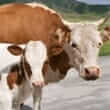Background
- Bovine colostrum is the pre-milk fluid produced by cow mammary glands during the first two to four days after giving birth. Bovine colostrum delivers growth, nutrient, and immune factors to the offspring.
- Traditional uses of bovine colostrum include for eye conditions, oral health, and respiratory tract infections. The investigation of clinical effects of bovine colostrum in humans began in the late 1980s and continues today.
- Bovine colostrum may be useful for exercise performance enhancement and gastrointestinal injury due to bowel disease and non-steroidal anti-inflammatory drugs (NSAIDs). Although early evidence looks promising, additional study is still needed to determine the safety and effectiveness of bovine colostrum.
- Hyperimmune bovine colostrum is also commercially available, and some evidence exists for its use, as well as the use of isolated immunoglobulins (antibodies). Most evidence is in support of its use for diarrhea associated with certain types of bacterial and viral infections or immune system deficiencies.
References
- Ashraf H, Mahalanabis D, Mitra AK, et al. Hyperimmune bovine colostrum in the treatment of shigellosis in children: a double-blind, randomized, controlled trial. Acta Paediatr. 2001;90(12):1373-1378.
View Abstract - Bolke E, Orth K, Jehle PM, et al. Enteral application of an immunoglobulin-enriched colostrum milk preparation for reducing endotoxin translocation and acute phase response in patients undergoing coronary bypass surgery--a randomized placebo-controlled pilot trial. Wien.Klin Wochenschr. 11-30-2002;114(21-22):923-928.
View Abstract - Casswall TH, Sarker SA, Faruque SM, et al. Treatment of enterotoxigenic and enteropathogenic Escherichia coli-induced diarrhoea in children with bovine immunoglobulin milk concentrate from hyperimmunized cows: a double-blind, placebo-controlled, clinical trial. Scand.J.Gastroenterol. 2000;35(7):711-718.
View Abstract - Crooks CV, Wall CR, Cross ML, et al. The effect of bovine colostrum supplementation on salivary IgA in distance runners. Int J Sport Nutr Exerc.Metab 2006;16(1):47-64.
View Abstract - Lindbaek M, Francis N, Cannings-John R, et al. Clinical course of suspected viral sore throat in young adults: cohort study. Scand J Prim.Health Care 2006;24(2):93-97.
View Abstract - Mero A, Nykanen T, Keinanen O, et al. Protein metabolism and strength performance after bovine colostrum supplementation. Amino.Acids 2005;28(3):327-335.
View Abstract - Nakajima K, Kinoshita M, Matsushita N, et al. Capillary affinity electrophoresis using lectins for the analysis of milk oligosaccharide structure and its application to bovine colostrum oligosaccharides. Anal.Biochem 1-1-2006;348(1):105-114.
View Abstract - Niklowitz P, Menke T, Giffei J, et al. Coenzyme Q10 in maternal plasma and milk throughout early lactation. Biofactors 2005;25(1-4):67-72.
View Abstract - Paddle, B. M., Wong, V. K., and Muller, B. D. The cytotoxic effect of anthrax lethal toxin on human lung cells in vitro and the protective action of bovine antibodies to PA and LF. J Appl Toxicol 2006;26(2):162-168.
View Abstract - Renehan AG, Zwahlen M, Minder C, et al. Insulin-like growth factor (IGF)-I, IGF binding protein-3, and cancer risk: systematic review and meta-regression analysis. Lancet 4-24-2004;363(9418):1346-1353.
View Abstract - Rollison DE, Newschaffer CJ, Tao Y, et al. Premenopausal levels of circulating insulin-like growth factor I and the risk of postmenopausal breast cancer. Int J Cancer 3-1-2006;118(5):1279-1284.
View Abstract - Schernhammer ES, Holly JM, Hunter DJ, et al. Insulin-like growth factor-I, its binding proteins (IGFBP-1 and IGFBP-3), and growth hormone and breast cancer risk in The Nurses Health Study II. Endocr.Relat Cancer 2006;13(2):583-592.
View Abstract - Schoen RE, Weissfeld JL, Kuller LH, et al. Insulin-like growth factor-I and insulin are associated with the presence and advancement of adenomatous polyps. Gastroenterology 2005;129(2):464-475.
View Abstract - Severi G, Morris HA, MacInnis RJ, et al. Circulating insulin-like growth factor-I and binding protein-3 and risk of prostate cancer. Cancer Epidemiol.Biomarkers Prev. 2006;15(6):1137-1141.
View Abstract - Shi R, Berkel HJ, Yu H. Insulin-like growth factor-I and prostate cancer: a meta-analysis. Br J Cancer 9-28-2001;85(7):991-996.
View Abstract







